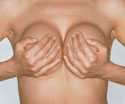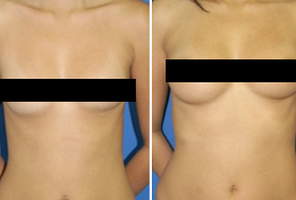What is a Breast Lift or mastopexy procedure?
A breast lift, or mastopexy, encompasses several different surgical procedures designed to alter the shape, tone, and overall appearance of the breasts. During the natural aging process, weight gain and loss, pregnancy, and other life events, the support structures of the breasts become stretched, leading to a change in the shape of the breasts and loss of elasticity (called ptosis).
The support structures of the breast include Cooper’s ligament, a ligamentous band that helps suspend the breast from the chest wall, muscles (pectoralis major and minor), and connective tissue (i.e. collagen, elastin) in the skin. Breasts can form a variety of different shapes and sizes and mastopexy, with or without augmentation, is designed to rebuild the support structures of the breasts, reshape the breasts, and remove excess skin to restore a more toned and fit appearance.
 The nature of the patient's aesthetic goals and the condition of the skin and breast tissue elasticity will dictate the type of procedure performed. Ptosis is graded by measuring how far the nipple hangs down relative to the inframmary crease. The inframmary crease (or fold) is where the breast meets the chest wall under the breast. To calculate ptosis, a ruler is placed across the chest into the inframmary crease and the distance between the center of the nipple and the top of the ruler is measured. If the nipple is above or just over the ruler, this is called Grade 1 ptosis. Grade 2 ptosis is defined as the nipple measuring 1-3 cm below the ruler. If the center of the nipple is more than 3 cm below the top of the ruler, this is called Grade 3 ptosis.
The nature of the patient's aesthetic goals and the condition of the skin and breast tissue elasticity will dictate the type of procedure performed. Ptosis is graded by measuring how far the nipple hangs down relative to the inframmary crease. The inframmary crease (or fold) is where the breast meets the chest wall under the breast. To calculate ptosis, a ruler is placed across the chest into the inframmary crease and the distance between the center of the nipple and the top of the ruler is measured. If the nipple is above or just over the ruler, this is called Grade 1 ptosis. Grade 2 ptosis is defined as the nipple measuring 1-3 cm below the ruler. If the center of the nipple is more than 3 cm below the top of the ruler, this is called Grade 3 ptosis.
Pseudoptosis occurs when the nipple is above the mammary crease but the breast itself has lost much of its elasticity. Assymetry (one breast is different size or shape than the other) may also be altered with mastopexy.
How are Breast Lift procedures performed?
Depending on the procedure, mastopexy can be performed with local or general anesthesia. The surgery can take anywhere from 1.5 to 4 hours under normal circumstances. Below are descriptions of a selection of different procedures that are used; note that there are many different names for similar procedures.
The Crescent procedure involves removing a crescent shaped piece of tissue from above the areola (from 10 o’clock to 2 o’clock) and then suturing the defect closed which lifts the nipple and breast upwards.
The Benelli lift removes a donut-shaped piece of tissue from around the areola and the defect is sutured with a stitch called a purse string suture.
The Benelli-Lollipop uses the same technique as the Benelli but also includes an incision from the areola to the inframammary fold. This allows more skin and breast tissue to be removed and reshaped.
The most common technique is called full mastopexy and is used when the degree of ptosis is maximal. In this procedure, an anchor-shaped incision is made around the nipple and down towards the inframmary crease. Incisions are also made along the base of the inframmary crease. Using such a procedure, the nipple can be moved up by as much as 8 cm.
Each patient has unique needs and goals so each procedure will vary depending on the patient and the cosmetic surgeon treating. It is important to have a clear idea of aesthetic goals as well as an understanding of how the procedure is to be performed prior to the onset of surgery.
What is the recovery period like after a Breast Lift procedure?
Immediately after surgery, breasts will be sore and swollen. Bandages and sometimes a drain (to drain excess fluid), as well as a supportive bra are part of the immediate post-surgery care. Wearing a supportive bra twenty four hours a day for several weeks is an important part of aiding the healing process. Drainage of fluid and crusting is normal. Movement and minor activities the first day after surgery is possible but most patients do not return to work for about a week. Strenuous activities, including sexual activities, should be avoided for several weeks. Each patient will experience a unique recovery time so a thorough discussion with a plastic surgeon regarding what is to be expected while healing is important.
What are the risks with Breast Lift or augmentation procedures and what preparation may be necessary?
There are multiple risks associated with breast lift and breast augmentation procedures. It is critical to understand these risks and to have realistic expectations regarding surgery outcome. Only through an in-depth discussion with a surgeon will the risks, benefits, and expected outcomes become clear.
Ceasing the ingestion of any and all over the counter, herbal, and prescription medications and vitamins that affect bleeding to decrease your risk of hematoma formation is vital to prepare the body for surgery. Patients should cease smoking for at least two weeks prior to surgery (even longer ideally), and smokers can face unique or elevated risks which should be thorougly understood. Due to this, discussing lifestyle and any forms of consumption which can affect the body's ability to heal should be thoroughly discussed with the cosmetic surgeon.
Infection is always a risk of surgery. Antibiotics may be taken post-surgery to minimize risk of infection. Post-surgery, breasts may stretch and change in ways that are unattractive. Furthermore, after implant insertion, a scar tissue forms around the implant which can cause the breast to feel firmer than normal. In extreme cases, the scar formation can distort the breasts and the implants which may require removal of scar tissue.
Breast lifts and implants are not expected to last forever. For example, the implant can break, leading to deflation of the breast. The fluid from the implant may then be absorbed by the body and the implant will need to be replaced. Implants generally must be monitored and may need replacing every ten years or so, depending on the patient's individual case. Over time, skin naturally will age and elasticity will gradually decline. This is a normal part of life.
The presence of implants can affect breast cancer screening and make it more challenging to acquire an accurate reading of breast tissue. Sometimes, tests other than mammography are ordered (i.e. MRI or ultrasound) to better visualize breast tissue after augmentation.
Breast implants can lead to the development of autoimmune diseases. However, studies have revealed that this risk appears to be the same for women with breast implants and women without implants. There are risks of allergic reactions to implants, which are essentially a foreign object being placed into the body. This can result in the need for removal of the implants and reconstructive surgery.
Nipple necrosis leading to loss of the areola and/or nipple is a rare but serious side effect when incisions are made near the areola. Nipple necrosis is caused by impaired blood flow to the nipple and areola after surgery. The risk of this complication is higher in smokers.
Asymmetry of the size and shape of the breast is a common complication. It is impossible to create perfect symmetry and small differences should be expected.
Inability to breast feed post-surgery can occur but many of the procedures used today usually do not affect breast feeding. The risk varies with the type of surgery.
Breast lift and augmentation procedures can lead to changes in skin sensitivity because removal of the skin involves cutting through nerves that influence sensation. Loss of sensation is usually minimal and returns over the course of a few months.
Fluid accumulation in the breast, called a seroma, can occur after breast lift or augmentation. Seromas can be drained and usually resolve within a few weeks. Accumulation of blood in the skin after surgery is called a hematoma and usually must be removed surgically. Hematomas can increase the risk of infection and may increase scarring.
Scarring occurs with any surgery and final scar appearance cannot be predicted. Scars can vary from a nearly invisible line to a large, raised, discolored scar depending on the body's reaction to healing. Unwanted scars can be treated through medical or surgical intervention.
This list is not exhaustive and the risks and potential side effects associated with breast lift or augmentation procedures ought to be treated seriously and in-depth discussion with a professional cosmetic surgeon is necessary to fully understand what to expect.
What is the cost of a Breast Lift procedure?
Breast lift costs vary based on location, the cosmetic surgeon, demand, the time and effort required during the procedure, as well as what's required during the procedure from start to finish (lab fees, anesthesiologist, hospital stay fee, etc.) Generally, spending anywhere from $4,000-$10,000 can be expected, and the cost of course can go higher if breast augmentation or reduction occurs at the same time.
The exact cost of your procedure is of course highly variable and based on your specific situation. To consult with a cosmetic surgeon and discuss breast augmentation and the overall cost, find a surgeon in your area that is right for you.
Disclaimer: This information is intended only as an introduction to this procedure. This information should not be used to determine whether you will have the procedure performed nor does it guarantee results of your elective surgery. Further details regarding surgical standards and procedures should be discussed with your physician.
By OnlineSurgery Staff
Updated: October 1, 2008

